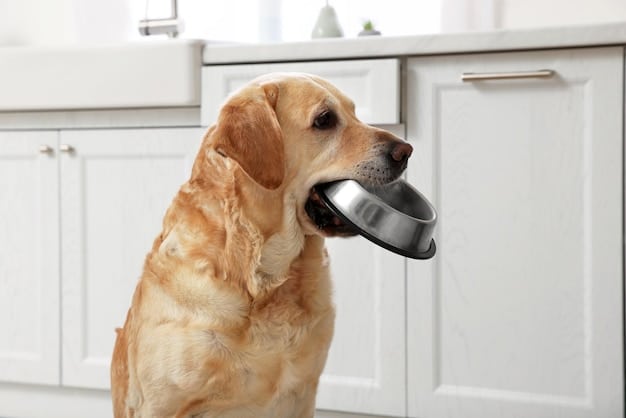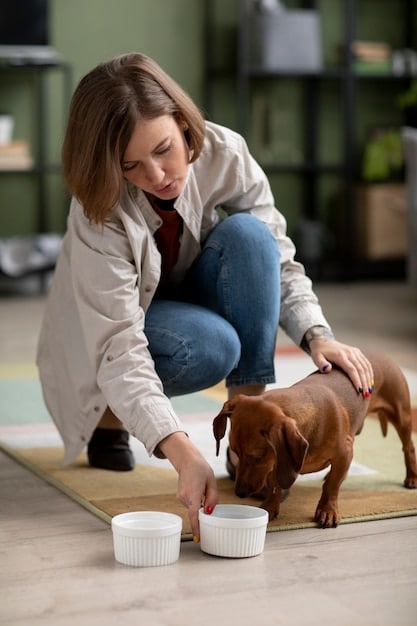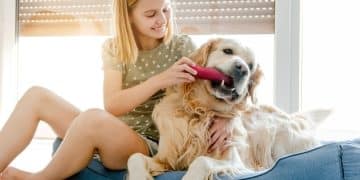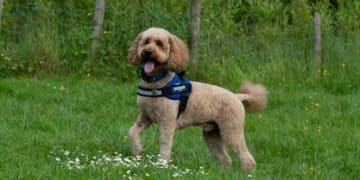Food Aggression: A Comprehensive Guide to Stop It

Food aggression in dogs is a serious behavioral issue that can be managed through consistent training, environmental adjustments, and, in some cases, professional intervention.
Is your furry friend turning into a growling monster during meal times? You might be dealing with food aggression, a behavior problem that can be stressful and even dangerous. This guide will provide you with the knowledge and tools to understand, manage, and ultimately address food-related aggression in your canine companion.
What is Food Aggression in Dogs?
Food aggression, also known as resource guarding around food, is a behavioral issue where a dog becomes defensive or aggressive when someone approaches their food, treats, or even the area where they are fed. It’s a natural instinct rooted in survival, but it can become problematic in a domestic setting.
Understanding the nuances of food aggression is crucial for effective management. It’s not simply about a dog being greedy; it’s often linked to anxiety and insecurity. Recognizing the triggers and understanding the underlying motivations are the first steps in helping your dog overcome this issue.
Signs of Food Aggression
Identifying food aggression early can prevent escalation. Here are some common signs to watch for:
- Stiffening body posture: The dog becomes rigid and tense while eating.
- Growling or snarling: Audible warnings when someone approaches.
- Showing teeth: A clear sign of aggression and discomfort.
- Snapping or biting: The most severe form of food aggression.
These signs may start subtly and gradually increase in intensity if not addressed. Paying close attention to your dog’s behavior during meal times is essential for early detection and intervention.
Why Do Dogs Develop Food Aggression?
Several factors can contribute to a dog developing food aggression:
- Genetics: Some breeds may be predisposed to resource guarding.
- Past experiences: Previous competition for food or scarcity.
- Anxiety: Feeling insecure about their food source.
- Learned behavior: Aggression that has been inadvertently reinforced.

By understanding the potential causes, you can tailor your approach to addressing your dog’s specific needs. A combination of training, environmental management, and behavioral modification can help alleviate the anxiety and insecurity driving the aggression.
In conclusion, food aggression is a complex issue influenced by various factors. Recognizing the signs early and understanding the potential causes are vital first steps in providing your dog with the support and training needed to overcome this challenging behavior.
Assessing the Severity of Food Aggression
Before embarking on a training program, it’s important to gauge the severity of your dog’s food aggression. This will help you determine the appropriate course of action and whether professional help is needed.
The intensity of the aggression can range from mild discomfort to outright aggression. Understanding where your dog falls on this spectrum is crucial for designing an effective management plan.
Mild Food Aggression
In cases of mild food aggression, a dog may exhibit subtle signs such as:
These dogs are generally not a bite risk, but their discomfort should still be addressed. With patience and consistent training, positive results can be achieved.
Moderate Food Aggression
Moderate food aggression involves more pronounced warning signs:
Dogs exhibiting these behaviors require more careful management and professional guidance may be beneficial.
Severe Food Aggression
Severe food aggression poses a significant safety risk:
These cases require immediate professional intervention from a certified dog behaviorist or veterinary behaviorist. Safety should be the top priority.

Assessing the severity of food aggression is a critical step in determining the best approach for your dog. It helps ensure that the training methods used are appropriate for the specific level of aggression, while prioritizing the safety of everyone involved.
In summary, accurately assessing the severity of food aggression is essential for creating a tailored management plan. Whether the aggression is mild, moderate, or severe, early intervention and consistent training can help improve your dog’s behavior and create a more peaceful mealtime environment.
Practical Strategies to Manage Food Aggression
Once you’ve assessed the severity of your dog’s food aggression, you can begin implementing practical strategies to manage and address the behavior. These strategies focus on changing your dog’s association with people approaching their food.
The key is to make your presence a positive experience for your dog, rather than a threat to their meal. This involves building trust and associating your approach with positive outcomes.
Hand Feeding
Hand feeding can help build trust and reduce anxiety around food:
- Start by offering a few pieces of food from your hand.
- Gradually increase the amount of food you offer.
- Eventually, transition to feeding entire meals from your hand.
This technique helps your dog see you as a provider rather than a potential threat to their food.
Adding Food to the Bowl
Another effective strategy is to approach your dog’s bowl while they are eating and add high-value treats or extra food:
- Approach the bowl calmly and slowly.
- Drop in a tasty treat or extra portion of food.
- Step back and allow your dog to continue eating undisturbed.
This helps change your dog’s association with your approach from a negative one to a positive one.
Creating a Safe Feeding Environment
A safe and predictable feeding environment can help reduce anxiety and aggression:
- Feed your dog in a quiet, low-traffic area.
- Ensure they are not disturbed while eating.
- Avoid approaching the bowl unexpectedly.
By creating a stress-free environment, you can help your dog feel more secure during meal times.
In conclusion, these practical strategies can help manage food aggression by changing your dog’s association with your presence during meal times. Consistency and patience are key to seeing positive results.
Training Techniques to Reduce Food Aggression
In addition to management strategies, specific training techniques can help reduce food aggression. These methods focus on building confidence, trust, and positive associations with people near the food bowl.
Positive reinforcement is key to these techniques. Rewarding calm behavior and gradually increasing exposure to people near the food bowl can help your dog feel more secure and less threatened.
“Leave It” Command
Teaching the “Leave It” command can be a valuable tool:
- Start by placing a treat on the floor and covering it with your hand.
- Say “Leave It” and wait for your dog to stop trying to get the treat.
- Reward them with a different treat from your hand.
Gradually increase the difficulty by leaving the treat uncovered.
Counter-Conditioning
Counter-conditioning involves changing your dog’s emotional response to your approach:
- Associate your approach with something positive, like a high-value treat.
- Gradually decrease the distance between you and the bowl.
- Reward calm behavior with treats and praise.
This technique helps your dog see your presence as a positive event.
Desensitization Exercises
Desensitization involves gradually exposing your dog to the trigger while keeping them under threshold:
- Start by standing far away from the bowl while your dog is eating.
- Slowly decrease the distance over time.
- Reward calm behavior with treats and praise.
If your dog shows signs of aggression, increase the distance and try again later.
In summary, training techniques like “Leave It,” counter-conditioning, and desensitization can help reduce food aggression by building trust and changing your dog’s emotional response to your presence near their food.
When to Seek Professional Help
While many cases of food aggression can be managed with consistent training and management strategies, some situations require professional intervention. Recognizing when to seek help from a certified dog behaviorist or veterinary behaviorist is essential for ensuring your dog’s safety and well-being.
If the aggression is severe, if you feel unsafe, or if the behavior is not improving with your efforts, it’s time to consult a professional. They can provide a tailored assessment and treatment plan to address your dog’s specific needs.
Signs You Need Professional Help
Here are some clear indicators that professional help is needed:
These signs indicate that the issue is beyond your ability to manage safely and effectively.
Finding a Qualified Professional
When seeking professional help, it’s important to find a qualified and experienced behaviorist:
Choosing a qualified professional ensures you receive the best possible guidance and support.
What to Expect During a Consultation
During a consultation, the behaviorist will:
Be prepared to provide detailed information about your dog’s behavior, triggers, and past experiences.
In summary, recognizing when to seek professional help is crucial for managing severe or persistent food aggression. A qualified behaviorist can provide the expertise and guidance needed to create a safe and effective treatment plan for your dog.
Preventing Food Aggression in Puppies
Preventing food aggression from developing in puppies is often easier than addressing it in adult dogs. Early socialization and positive reinforcement can help puppies develop a healthy relationship with food and people around their meals.
By establishing positive associations with your presence during meal times, you can help your puppy feel secure and less likely to develop resource guarding behaviors.
Early Socialization
Expose your puppy to different people and experiences around food:
This helps your puppy learn that people near their food are a good thing.
Positive Reinforcement
Use positive reinforcement to create positive associations with your presence during meal times:
- Approach the bowl, drop in a high-value treat, and step back.
- Praise and reward calm behavior.
- Avoid taking the bowl away from your puppy.
This helps your puppy see you as a provider, not a threat.
Teaching Resource Sharing
Teach your puppy to share resources from a young age:
- Offer a toy, let your puppy play with it, and then offer a tastier treat in exchange.
- Gradually increase the duration you hold the toy before giving the treat.
- Always make the exchange positive and rewarding.
This teaches your puppy that sharing can be rewarding.
In summary, preventing food aggression in puppies involves early socialization, positive reinforcement, and teaching resource sharing. These strategies help puppies develop a healthy relationship with food and people around their meals, reducing the likelihood of developing aggression later in life.
| Key Point | Brief Description |
|---|---|
| ⚠️ Identifying Food Aggression | Recognize signs like growling or stiffening during meals. |
| 🖐️ Hand Feeding | Build trust by offering food directly from your hand. |
| 🦴 Adding Food to Bowl | Approach the bowl and add treats to create a positive association. |
| 👨⚕️ Seeking Professional Help | Consult a behaviorist for severe cases or lack of improvement. |
Frequently Asked Questions
▼
Food aggression can stem from genetics, past experiences of food scarcity, anxiety, or learned behaviors where aggression was inadvertently rewarded.
▼
Signs include stiffening, growling, showing teeth, snapping, or biting when near their food. Mild signs involve eating faster when approached.
▼
Yes, especially severe cases. Severe food aggression involves biting, lunging, or showing intense possessiveness, posing a safety risk.
▼
While “cured” might not be accurate, it can be managed effectively with consistent training, environmental adjustments, and sometimes professional help.
▼
Seek professional help if your dog’s aggression is severe, not improving, or if you feel unsafe around them during feeding times.
Conclusion
Addressing food aggression requires patience, consistency, and a deep understanding of your dog’s behavior. By employing the strategies and techniques outlined in this guide, you can create a safer and more harmonious mealtime environment for both you and your furry friend. Remember, early intervention and a proactive approach are key to managing and preventing food aggression, ultimately strengthening the bond you share with your canine companion.





